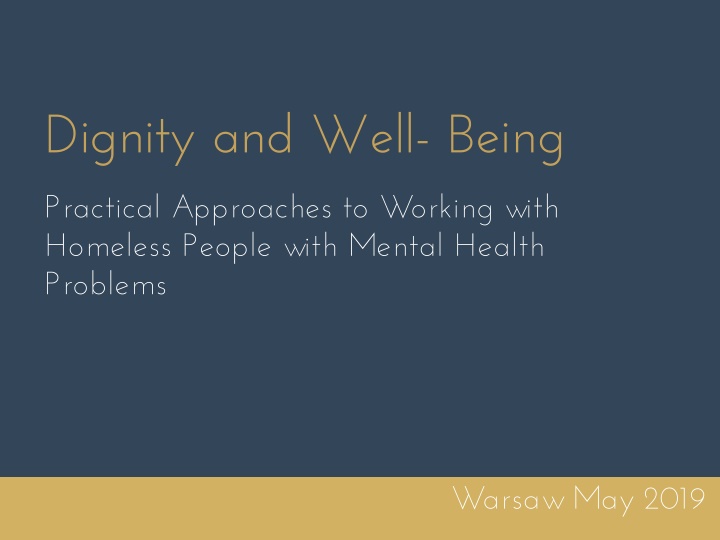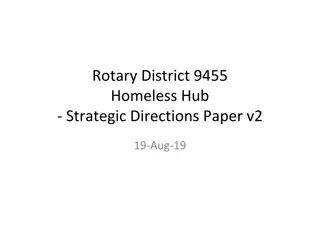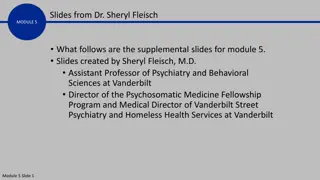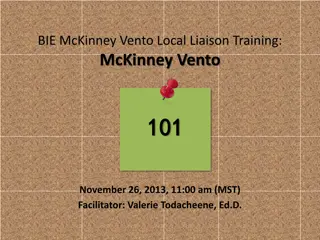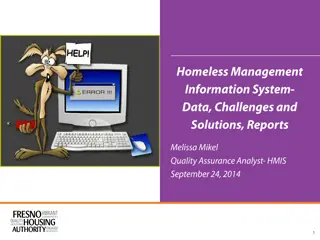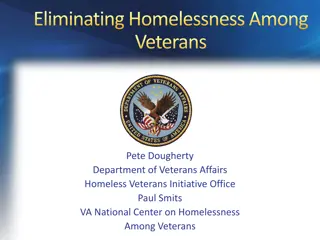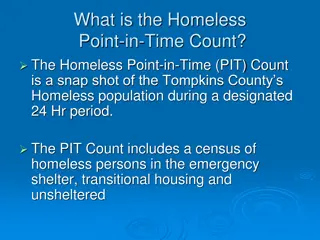Practical Approaches to Working with Homeless People with Mental Health Problems
This content discusses the importance of networking in addressing the needs of homeless individuals with mental health issues. It emphasizes the complexity of the phenomenon and the benefits of building a comprehensive understanding of the problem. The multi-layered approach to networking, main ideas, and steps to build a network are highlighted, focusing on enhancing interventions, sharing responsibilities, and preventing burnout.
Download Presentation

Please find below an Image/Link to download the presentation.
The content on the website is provided AS IS for your information and personal use only. It may not be sold, licensed, or shared on other websites without obtaining consent from the author.If you encounter any issues during the download, it is possible that the publisher has removed the file from their server.
You are allowed to download the files provided on this website for personal or commercial use, subject to the condition that they are used lawfully. All files are the property of their respective owners.
The content on the website is provided AS IS for your information and personal use only. It may not be sold, licensed, or shared on other websites without obtaining consent from the author.
E N D
Presentation Transcript
Dignity and Well- Being Practical Approaches to Working with Homeless People with Mental Health Problems Warsaw May 2019
NETWORKING DEFINITION Networking is a process which fosters the exchange of information, ideas and practices among individuals or groups that share a common (https://www.investopedia.com/terms/n/ networking.asp) interest
REASONS FOR NETWORKING Complexity of the phenomenon: huge number of agencies involved (health care, psychological, social, housing, educational) Inability of the person in need to build (re-build) his own network and to connect with the different agencies Multiple needs that no institution can respond to alone
REASONS FOR NETWORKING Build a more comprehensive understanding of the problem Design a better set of interventions Support the organisation of any intervention Overcome limitations organisation Overcome schedule gaps Help to persist of individual
NETWORKING: A MULTI- LAYERED APPROACH a) STRUCTURAL: the whole organisation participating in an explicit and agreed way (formal, informal, governmental and non-governmental, public and private) b) OPERATIVE: the network is made of people belonging to the organisations, directly involved in the specific case management. Such a front line staff design tailored intervention and follow the process in the field
MAIN IDEAS Avoid the recurrence and overlapping of the interventions Share responsability Share the burden, overcome feeling of solitude and disqualification Prevent defensivedelegation Feel in turn recognised and appreciated Leverage over proactive elements Reduce burn out
TO BUILD A NETWORK Detect the knots of the net Clear view of each player s role Respect identity and values Acknowledge freeplayers Share common goals Work together considering complementarity, coherence and sufficiency of the intervention
DIFFICULTIES Different values, cultures, languages Power imbalance Decision making power Overcome the feel of fear and suspiciousness Too many on the boat Poor communication flow Lack of a front line case manager Convert the facilitator into the only person in charge Gap between structural and operative level Personal data protection (General Data Protection Regulation, UE 2016/679)
PREVENTING DIFFICULTIES Build relationship Establish common objectives Empower communication Build a win-win playground Nominate a facilitator for each project Establish a memorandum of understanding Meetings planned and unplanned Decision power
GOOD PRACTICES Feed-back when the patient gets better Concessions between networking partners, to facilitate collaboration in an equal way Include a certain amount of partners, to avoid overloading Diversity: the same solution may not fit for all the patients Responsibility: each partner for his part Fulfil the commitments to increase confidence Shared training helps to build an esprit de corps Explore new ways and new services
